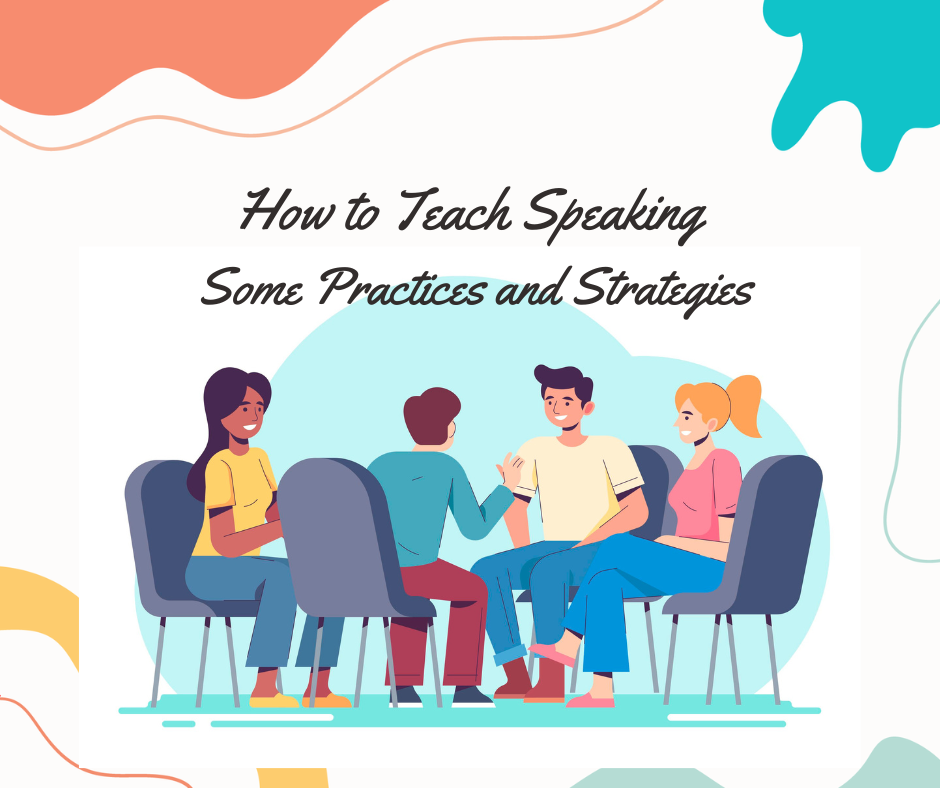In an episode of the comedy series Modern Family, Gloria, a Colombian immigrant mother living in the US, has finally enough of her family’s jokes about her accent. “Do you know how smart I am in Spanish?”, she shouts at her husband before doing a dramatic hair flip and walking away.
Her experience resonates with many non-native English-speaking viewers who also often feel belittled for their accents or “non-perfect” way of speaking.
The second we open our mouths, we give away a lot about ourselves: our accent or dialect reveals our place of origin and sometimes social status. People make assumptions about each other’s education level, intelligence, and personality based on how they speak. Therefore, many English learners avoid speaking for fear of making mistakes, because they struggle with their accent, or because they are simply too shy to express themselves.
Teachers hope to instill a sense of confidence and competence in their students to help them on their pathway from beginner to fluency. Many instructors spend a significant amount of classroom time teaching and practicing speaking – sometimes with varying results.If you are looking for a way to improve your students’ speaking competence, read on. We collected our favorite strategies and exercises for you to get you started.
Teaching Speaking to English Students of Different Levels
One size doesn’t fit all. Nowhere is this more true than in the classroom. Your students likely arrive with various prerequisites and initial English levels, they come from different backgrounds and had varying degrees of exposure to English. Luckily, you can use various strategies and exercises to teach speaking to students of different levels which can be easily combined in heterogeneous classrooms.
Beginners
Getting Beginners to speak is often not too difficult. Simple exercises and repeating phrases and dialogues are key. However, what if you want your learners to produce English, not merely verbally fill in the blanks or read out sentences from your textbook?
Focus on getting a message across. At this stage in their learning, the vocabulary and grammar knowledge of your students is still quite limited, but that doesn’t mean they can’t communicate. Give your students real-life scenarios (introducing themselves, going shopping) and let them role-play using verbal and non-verbal communication with a focus on communicating and delivering a message, not correctness. Let them make liberal use of visual aids. They might be surprised how much they can communicate with a few words. Take a look at Poodll’s mini lessons for easily implemented speaking activities.
As always, the British Council has a great selection of speaking exercises for the beginner’s level. For more tips on how to teach speaking to beginners, take a look at this video.
Intermediate Learners
Practising speaking with intermediate learners can be difficult. At this stage, students are often aware of their mistakes and perceived shortcomings and might feel shy or inhibited. Much like when teaching beginner students, the goal should be on getting a message across. A communication situation is successful if all parties understand each other, not if they speak with perfect grammar and pronunciation. Help your students let go of the idea of perfection.
Encourage your students to use varied vocabulary. Instead of simple words like “good”, “bad”, or “very”, ensure that they challenge themselves and use appropriate synonyms.
Poodll uses its in-built transcription feature which transcribes and evaluates your students’ speech and supports them with their pronunciation and fluency. Take a look at our interactive transcript player for an easy speech-teaching solution.
TeachIt also has collected a wide selection of intermediate-level speaking resources for teachers. For a video guide on teaching speaking to intermediate learners, click here.
Advanced Students
Teaching advanced students is both rewarding and challenging. At this level, students usually have a good command over vocabulary and grammar issues, expanding the topics you can discuss in your classroom as well as the complexity of the material.
Debate clubs, roleplays, and even creating short films or podcasts are great ways to teach speaking at this level. If you are in need of inspiration with regard to topics, check out this website.
The challenge of teaching advanced students lies in teaching the finer points of pronunciation and focusing on the correct use of language.
Poodll uses AI to assess and guide your students’ pronunciation, ensure accuracy, and give timely feedback. If your students enjoy learning pronunciation with poetry, this lesson plan provides you with more ideas and exercises. You can also take a look at this free webinar on teaching English to advanced learners.
Strategies and Methods for Teaching Pronunciation
Most of these strategies can be applied to learners of all language levels.
Embrace Accents
Many students feel shy about their accents which prevents them from speaking. The fact is, that many English learners will retain some sort of accent, no matter how much they practice or how much exposure they have to English. Their accent might even change over their lifetime. Even native speakers have regional accents.
If the accent does not prevent your students from being understood, make a point of embracing it in your classroom. An accent is what makes your students unique.
If you want to support your students in embracing their accents and need some statistics to back you up, check out this British Council video series.
We can’t all speak like the King of England or a BBC presenter. The most important thing for your students is that they are understood.
The 4-3-1 Method
Linguistic Professor Paul Nation first developed this method that has students speak for four minutes, then three minutes, and finally two minutes about one specific topic. This exercise focuses on fluency, the ability to talk naturally and without too many pauses. It’s great for intermediate and advanced learners.
The implementation is simple:
- Introduce a topic and prepare relevant vocabulary
- Give students time to prepare
- Divide students into groups or pairs
- Have one student speak for four minutes without interruption, the others listen
- Give them time to rest
- Students change partners or groups and give the same speech in three minutes
- Rest again
- Students change again and have two minutes to give the speech
- Students reflect together
Why does this method work? When given four minutes, students generally speak slower and with more pauses as they develop their thoughts. In the following intervals, they will have to get the same information across in a shorter period. They will most likely limit their pauses and increase their speaking speed, especially because they have already practiced talking about the topic. The 4-3-2 method is proven to work and a fun and effective speaking exercise.
Use Tech to Your Advantage
Some students might feel shy speaking to their peers or teachers, regardless of their English level. Self-paced exercises are a great way to build up their skills and confidence.
Poodll Solo allows students to record their speaking exercises and uses AI to auto-grade them. Learners receive immediate feedback on their speaking and pronunciation. Practicing with an AI allows them to speak freely without the fear of embarrassment and mistakes. You can use self-graded exercises as complementary to pair work and in-class speaking or on their own.
Sign up for your free Poodll test account here and assign auto-graded exercises to your students.
Five Exercises Outside the Classroom
Combine these strategies and exercises in your classroom to support your students’ speaking skills. However, classroom time is often limited to a few hours a week – not enough to become a proficient speaker. Assign your students these five easy exercises to improve their speaking. Even just five to ten minutes a day will make a notable difference.
Sing Along
Ask students to listen to their favorite English song over and over again. Most likely, they will already know many passages by heart. Have them look up the lyrics online and read them while listening. Eventually, your students will be able to belt out their favorite song in the shower, in the car, or just sitting in front of their laptops. Without making it feel like tedious work, they will have expanded their vocabulary and improved their pronunciation.
Talk to Yourself
Many students feel shy about talking to others in English – especially when they are at the beginning or middle stage of their learning journey. Ask your students to talk to themselves when they are alone.
Let them narrate what they are doing or make up conversations in their head. The key is to really talk out loud. Ideally, your learners would practice in front of a mirror to see how their mouth moves, but even just narrating their clearing or cooking process is a great start.
Twist Tongues
Tongue Twisters are popular for a reason. They draw attention to difficult-to-pronounce sounds or words and make sure that speakers concentrate when saying them. Your students can either practice alone or with friends and family members, or you can start a friendly tongue twister competition in your classroom.
Check out this extensive collection of evergreen and unusual tongue twisters or point your students to videos like this where they can listen to the twisters first before practicing.
Celebrate Wins (No Matter How Small)
Communicating in a new language can feel overwhelming. After all, there is an almost infinite amount of mistakes to make. Make sure that your students celebrate wins – however small they might be.
Maybe they were able to order in a restaurant when on vacation, perhaps they switched their voice assistant to English and it finally understood them, or they were able to chat with another player in an online game. Every successful communication situation is a cause for celebration and a sign that your students are on the right track.
Playback Time
Ask your students to record themselves and listen to their own voices. Chances are that they will detect their mistakes and can correct them on their own.
Poodll allows you to give your students recording assignments in Moodle. Learners can record themselves directly into Moodle HTML areas, assignments, and quizzes, submit recorded assignments, and listen to their recordings. An AI will provide them with instant feedback and suggestions for improvement
Conclusion
Learning to communicate effectively in a foreign language is one of the most challenging and important skills to acquire. Without speaking, learners will never make rewarding connections with natives, they won’t be able to navigate a foreign country, or study and work abroad.
We hope our speaking tips and tricks will help you plan your next speaking class. Make sure to create a supportive classroom atmosphere, use a variety of mediums and resources, and implement auto-grade features, where possible.
Easy recording options, real-life exercises, interactive captions, subtitles, auto-grading, and fun mini-lessons: Poodll makes teaching speaking a breeze. If you haven’t already, sign up for your free test account to find out all that Poodll has to offer.
And if you are teaching with Poodll already, why not check out our Poodll courses or our blog section to stay updated on our latest developments?













